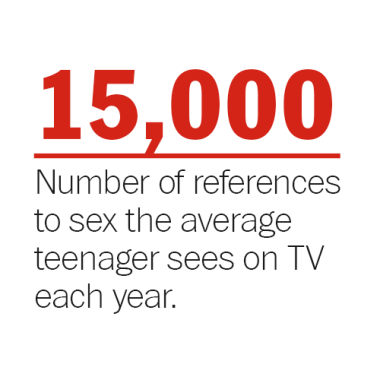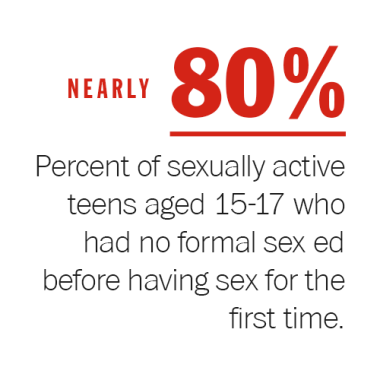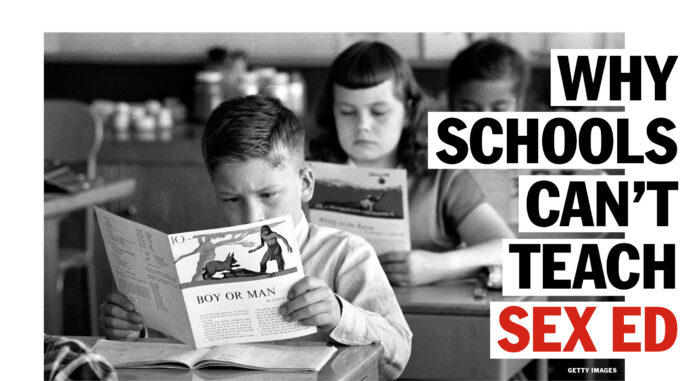By Alexandra Sifferlin
Published on TIME
In spring 2014, parents in the normally progressive Bay Area city of Fremont, California, started a campaign to get a book removed from the 9th grade curriculum for the five district high schools, arguing it was inappropriate for their 13 and 14-year olds. They hired a local lawyer and put together a petition with more than 2500 signatures.
Their target: Your Health Today, a sex-ed book published by McGraw Hill. It offers the traditional advice and awkward diagrams plus some considerably more modern tips: a how-to for asking partners if they’ve been tested for STDs, a debate on legalizing prostitution. And then there was this: “[One] kind of sex game is bondage and discipline, in which restriction of movement (e.g. using handcuffs or ropes) or sensory deprivation (using blindfolds or masks) is employed for sexual enjoyment. Most sex games are safe and harmless, but partners need to openly discuss and agree beforehand on what they are comfortable doing.”
“I was just astounded,” says Fremont mom Teri Topham. “My daughter is 13. She needs to know how boys feel. I frankly don’t want her debating with other 13-year-olds how well the adult film industry is practicing safe sex.” Another parent, Asfia Ahmed, who has eight and ninth grade boys, adds: “It assumes the audience is already drinking alcohol, already doing drugs, already have multiple sexual partners…Even if they are experimenting at this age, it says atypical sexual behaviors are normal. ”

But school board members contend that 9thgrade students have already been exposed to the contents of the book—and much, much more. They argue that even relatively modern sex ed has even not begun to reckon with what kids are now exposed to in person and online.
The singer Rihanna, for example, has legions of young fans. Her music video for the song “S&M”—viewed more than 57 million times on YouTube so far—shows the artist, pig-tied and writhing, cooing “chains and whips excite me.” It then cuts to her using a whip on men and women with mouths covered in duct tape.
Overexposed Teens
The average American young person spends over seven hours a day on media devices, often using multiple systems at once. Studies show that more than 75% of primetime TV programs contain sexual content, and the mention of sex on TV can occur up to eight to 10 times in a single hour. And that’s the soft stuff: A national sample study of 1,500 10 to 17-year-olds showed that about half of those that use the Internet had been exposed to online porn in the last year.
Uncensored media is not harmless. Longitudinal studies suggest exposure to sexual content on TV and other media in early adolescence is linked to double the risk of early sexual intercourse, and young people whose parents limit their TV time are less likely to partake in early sexual behavior. Other studies have found that 10% of young women who had their first sexual experience in their teenage years say it was not their choice, and the younger they were, the more likely this was the case. While the vast majority of primetime programming contains sexual content, only 14% of sexual incidents mention the risks or responsibilities associated with sexual activity according to research from the American Academy of Pediatrics.
“I was sexting and sending pictures to a guy older than me because he told me he loved me and i believed him and he showed everyone my picture and i had everyone asking me for photos and making fun of me and calling me a slut.”
“me n my girlfriend have been datin a year an almost 2months, she has sent me naked pics of her and she asked me to send her some of me naked, but i dont want too and i dont want to lose her either.”
“My girlfriend will text me good morning, if i dont respond right away she will send a question mark with a question, then a few more question marks, then call me. If i don’t respond she gets realy upset and angry. is this abuse? what do i do?”

Young people now engage in relationships increasingly via technology, which means they’re able to connect in a variety of ways and at a speed and frequency not known to prior generations. They also appear to be more comfortable showing skin. A 2014 survey published in the journal Pediatrics among over 1,000 early middle school students found 20% reporting receiving sexually explicit cell phone text or picture messages (more colloquially known as “sexts”) and 5% reporting sending them.
While many parents think that explaining the consequences of sending out explicit images will get teens to stop, they may be missing the point. “There’s a pressure that people feel to send a sext as a digital currency of trust,” says Emily Weinstein a Harvard University doctoral student who collected the texts above from an online forum run by MTV, for a study on the digital stress of adolescence. “It’s a way to say to someone, here is a thing that could destroy me, I trust that you won’t use it.”
Sex Ed Is Not Keeping Up
Not only does sex education still virtually not exist in some areas of the country, but school programs that do teach kids about what used to be called the facts of life start too late. A recent CDC study showed that among teens ages 15-17 who have had sex, nearly 80% did not receive any formal sex education before they lost their virginity. Or, if they did, it was only to discourage them from being sexually active. “Parents and legislators fail to understand that although they may favor abstinence-only sex education (despite the lack of any evidence of its effectiveness), the media are decidedly not abstinence only,” reads a 2010 American Academy of Pediatrics policy statement.
School-wide sex education largely ignores gay men and women. “I think the Internet is one of the most commonly used sources for young LGBT folks to gain information,” says Adrian Nava, 19, who says his question about same sex relationships in his Colorado high school sex ed class that was shot down by the teacher. “In some ways it’s great because online forums tend to be supportive and positive. But there’s so much misinformation that reinforces negative feelings.”
Sex ed courses tends to hyper-focus on the girls. “Girls are the ones who have babies,” says Victoria Jennings, director of the Institute for Reproductive Health at Georgetown University, whose research has shown there are globally more programs developed to help young girls navigate their sexuality than to help boys. Given the fact that recent CDC literature shows 43.9% of women have experienced some form of unwanted sexual violence that was not rape, and 23.4% of men have experienced the same, public health experts agree both sexes need education on appropriate behavior.
Reference: https://time.com/why-schools-cant-teach-sex-ed/
Comment: This article reveals the controversial situation of Sex Ed, many teens didn’t receive proper education from either the school or the parents before they had their first sex. The questions related to sex are avoided and teens often receive information from medias which have a rather high underlaying risk. The current Sex Ed often focused on women and ignores men and LGBTQ group, and there are some stereotypes involved when developing the content. One thing that’s interesting to consider is that teens considered explicit images as way of showing their trust, when sex is not understood correctly, it may result in harming themselves.





Hi Sherry, I think the points you bring up about the LGBTQ community are certainly true. It was also interesting to learn that the internet is a place many teens in the LGBTQ community go to for information. Unfortunately the article talks about how much of this info is actually false. Is there a way we can leverage knowing that teens are seeking answers to their questions on the internet as a way to get a message to them?
I think another interesting part of this article is the last quote mentioned about texting. Texting is a big part of relationships now and with that comes a whole other set of questions and boundaries to understand. I wonder how these questions can be better addressed under the umbrella of social-emotional sex education.